Physical Address
304 North Cardinal St.
Dorchester Center, MA 02124
The overall incidence of pediatric pelvic fractures is 1 per 100,000 children per year. Although rare, these fractures are identified in pediatric trauma patients at a reported rate between 2.4% and 7.5%. This rate increases to nearly 20% in polytraumatized patients. There is a male predominance with a male-to-female ratio of 1.4:1 and an average age of 9 years. Sacral fractures are present in 0.16% of pediatric trauma and 4.76% of pediatric pelvic fractures. Acetabular fractures constitute 0.8% to 15% of fractures of the pelvis in children.
The immature pelvic bone consists of three primary ossifications centers along with their corresponding physes undergoing endochondral ossification. These ossifications centers represent the developing ilium, ischium, and pubis. The physeal portion of the ilium, ischium, and pubic bones converge at the immature acetabulum and form the Y-shaped triradiate cartilage ( Fig. 11.1 ). The triradiate cartilage typically closes at 12 to 14 years of age and is a reliable predictor of skeletal maturity. In addition to these primary ossification centers, a number of secondary ossifications centers arise in the pelvis as development continues ( Fig. 11.2 ). It is important for treating clinicians to be familiar with these structures, as it is key to accurately interpreting radiographic studies of the immature pelvis. Children also have thicker periosteum and more elastic pubic symphyseal and sacroiliac (SI) joints compared with adults. For this reason, multifocal pelvic ring fractures and ligament ruptures are rare in children as compared with adults. The high cartilaginous volume and thick periosteum found in the immature pelvis provides a greater capacity for energy absorption and helps mitigate fracture displacement. However, fractures occurring within the cartilaginous regions of the pelvis can often make diagnosis more difficult. Furthermore, fractures in these regions can result in growth disturbances that may lead to deformity or secondary dysplasia.
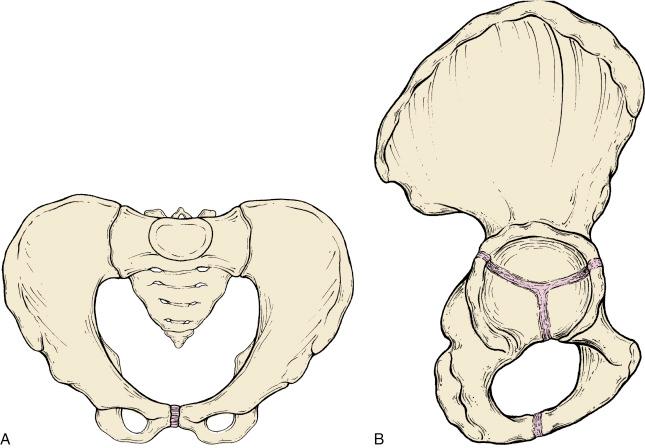
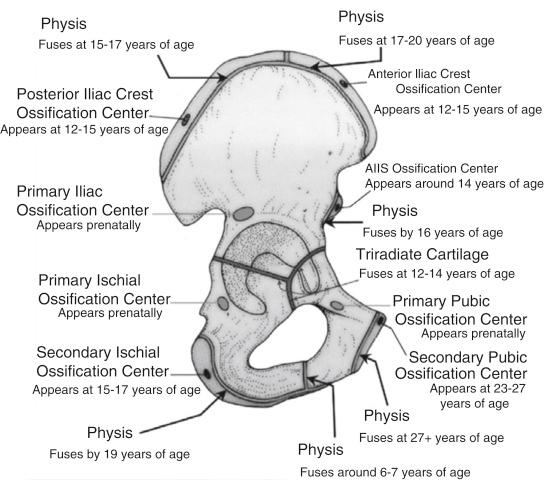
In addition to their more durable pelvic rings, children also have a more effective hemostatic response to pelvic trauma. Children have smaller, more compliant blood vessels, allowing better vasoconstriction in response to pelvic hemorrhage. Furthermore, their thick periosteum reduces fracture displacement and has a tamponade effect on bleeding from osseous surfaces. For these reasons, pelvic fractures in children rarely lead to life-threatening arterial hemorrhage, which has been reported in 10% to 20% of adult pelvic fracture cases.
Because the pediatric pelvis is more resilient to sustaining a fracture, pelvic and acetabular fractures in children are generally the result of high-energy trauma. The majority of pediatric pelvic fractures are the result of pedestrian versus motor vehicle accidents. This mechanism accounts for 39% to 78% of cases in the pediatric population, whereas the majority of adult pelvic fractures are the result of motor vehicle accidents (passenger injuries). Motor vehicle passenger injuries are the second most common cause of pediatric pelvic fractures, accounting for 10% to 30% of cases. Other common mechanisms include falls from height, bike and motorbike accidents, and high-energy sports injuries. These differences in mechanism of injury also play a role in the different mortality rates from pelvic injury seen between these two populations. Children are more likely to be struck on the side, resulting in lateral compression–type injuries, which typically reduce pelvic volume and blood loss. Adults often sustain head-on motor vehicle collisions, resulting in anterior-posterior compression injuries, which can result in life-threatening hemorrhage and mortality.
Avulsion fractures of the pediatric pelvis are much more common than pelvic ring and acetabular fractures. They typically occur as the result of traction from an attached muscle on secondary ossification centers, including the ischial tuberosity, anterior-superior iliac spine (ASIS), anterior-inferior iliac spine (AIIS), and iliac apophysis. These injuries are often the result of low-energy mechanisms and often occur during athletic participation. The vast majority of these injuries can be treated nonoperatively—a period of protected weight-bearing followed by gradual strengthening and return to activities. Avulsion fractures displaced greater than 2 cm have a higher rate nonunion and may be treated with open reduction internal fixation.
Pelvic fractures are associated with additional injuries in approximately 58% to 87% of cases. These injuries include both visceral and additional skeletal injuries. The most commonly associated fractures include femur, skull, ribs, tibia and fibula, clavicle, facial bones, and humerus in decreasing order of incidence. Children with at least one other associated fracture have a significantly higher incidence of head and abdominal injuries, as well as an associated need for blood transfusions. The visceral injuries directly related to the pelvic injury include bladder and urethral injuries, traction or avulsion injuries of the lumbosacral plexus, and injury to the major and minor arterial and venous systems, with resultant hemorrhage. Injuries associated with high-energy blunt trauma may involve the pulmonary, cardiac, gastrointestinal, and central nervous systems. Lateral compression (LC)–type pelvic injuries are associated with neurologic injury, including closed head injuries, with up to 57% of pediatric pelvic fracture patients sustaining a concomitant neurologic injury. Head trauma has been reported to be responsible for 75% of deaths seen in children with traumatic pelvic fractures. Identification of a pelvic injury in the primary phase of the resuscitation and injury survey should alert the physician to the possibility of these associated injuries. The associated injuries are often more difficult to treat and generally have a greater effect on the patient’s overall outcome than does the pelvic fracture.
The evaluation of the pediatric trauma patient must be systematic and multidisciplinary, including the surgical trauma team, emergency medicine personnel, and orthopedic specialists.
As mentioned, pelvic and acetabular fractures in the pediatric population typically occur secondary to children being struck by automobiles or as a result of their being unrestrained passengers in motor vehicle accidents. A history of high-energy trauma should direct the emergency medical service team to an appropriate response in the field and during transfer of the patient to a regional trauma center. The history of high-energy injury mechanism dictates full-scale primary and secondary surveys, institution of large-bore venous access, and other resuscitative measures as outlined in previous chapters. Apophyseal avulsion injuries are generally caused by lower-energy athletic injuries and typically do not require trauma system activation.
The evaluation procedure for a pediatric trauma patient suspected of having pelvic trauma should follow Advanced Trauma Life Support (ATLS) guidelines beginning with primary survey, including airway, breathing, and circulatory status. Special attention should then be given to injuries of the head, chest, abdominal viscera, spine, and pelvis to evaluate for potential life-threatening injuries. Hemodynamically unstable patients with suspected pelvic injury should be promptly evaluated with an anteroposterior (AP) pelvis radiograph and stabilized with a sheet or pelvic binder as dictated by radiographic findings. Concurrently, the trauma team should evaluate the patient for other sites of hemorrhage and treat accordingly. An algorithm for the trauma bay treatment of these patients has been proposed by Hak et al ( Fig. 11.3 ).
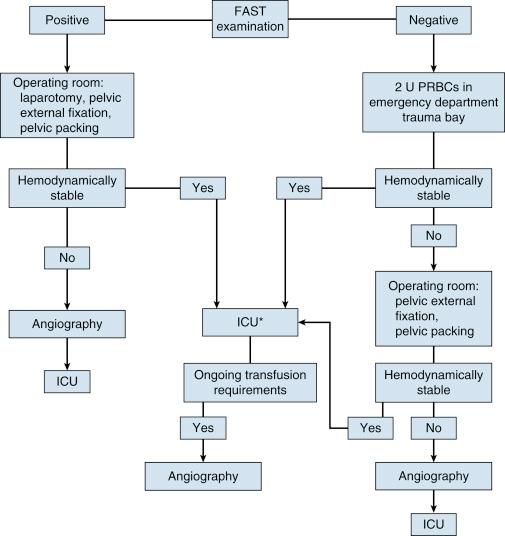
Once the primary survey is completed and the patient is found to be hemodynamically stable, attention may be turned to the secondary survey, including evaluation for potential pelvic injury. Visual inspection of the pelvic region, including the scrotum, vagina, urethra, and perineal region, is necessary to rule out potential injury. Contusions, abrasions, and areas of degloving are identified and recorded. Although Morel-Lavallee (internal degloving) lesions are uncommon in children, they can be seen in overweight children and adolescents. In the perineum, lacerations are often the result of open fractures. Vaginal lacerations are not unusual, and a digital pelvic examination should be performed in all female patients with a displaced anterior ring fracture; preferably, this examination is done with the patient under sedation or with the use of an anesthetic in prepubescent children. Similarly, a digital rectal examination is done to check for gross blood or boney fragments, indicative of a rectal perforation or sphincter injury.
When the inspection is completed, pelvic stability is evaluated, preferably while the patient is still on the backboard. AP stability is assessed by the clinician, placing the palms of the hands on the anterior iliac crests and applying posteriorly directed pressure ( Fig. 11.4 ). By placing the palms on the lateral aspect of the anterior crests and applying pressure directed toward the midline, the examiner can check for rotational instability ( Fig. 11.4 ). Pain on AP or medially directed pressure in a conscious patient is carefully documented. In addition, the examiner uses palpation along the posterior iliac spine, SI joint, and sacrum to look for pain consistent with a posterior pelvic ring injury. A final check on vertical or rotational instability can be made by assessment of the relative height of the anterior superior iliac spine and relative leg lengths.
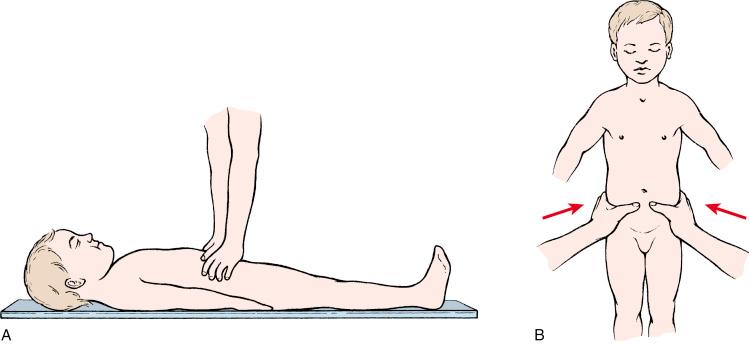
After the inspection and palpation phases are completed, a thorough evaluation of the arterial circulation is made. The femoral, popliteal, dorsalis pedis, and posterior tibial pulses are palpated. If nonpalpable, a Doppler ultrasound examination is done for determination of biphasic pulsatile flow. Limb temperature is assessed by palpation. Finally, in an alert and cooperative patient, a gross motor examination of all major muscle groups in the lower extremity is completed bilaterally, as well as a sensory examination with light touch and pinprick. The latter should include the perirectal area because of the frequent involvement of the sacral plexus with sacral fractures. This is not possible in younger children who are unable to cooperate with the demands of this type of evaluation. Rectal tone should be assessed and documented during the digital rectal examination.
An important part of the initial evaluation of a multiply injured child is an AP radiograph of the pelvis. Gonadal shielding should not be used because it may obscure the anterior pelvic ring. It is important to note that the pubic symphysis in very young children may be 10 mm to 12 mm wide as compared with 2 mm to 4 mm wide in adult patients. It is important to thoroughly evaluate all obtained imaging studies, as the presence of one injury can often interfere with the detection of additional injuries. Two additional views are indicated if a fracture of the pelvic ring is identified on the initial radiograph: a 30- to 45-degree (aimed distally) inlet view or “down shot,” which will demonstrate a posterior pelvic ring injury and any anterior/posterior displacement more clearly, and a 40- to 45-degree (aimed toward the head of the patient) “tangential,” outlet, “brim shot,” or “up view,” which will delineate the anterior pelvic ring and help assess vertical stability ( Figs. 11.5 and 11.6 ). Both are helpful for identifying internal or external rotation of one of the hemipelves relative to the other. These three radiographs can help determine the mechanism of injury and the form of treatment for most fractures. Sacral fractures and SI joint injuries are frequently missed with standard plain radiographs and may require computed tomography (CT) for further evaluation. CT is also helpful in diagnosing pelvic hematoma, an important factor in the initial treatment of the patient. Cut intervals of 2 to 3 mm are generally sufficient for delineating the skeletal injury. Images should be obtained from the L5 vertebral body to the lower pelvic region in the axial plane with the use of contiguous sections and soft tissue and bone window techniques. Because CT is becoming more widely used to screen for abdominal injuries, the images should be scrutinized by the treating orthopedist. 71 These images can be useful for detecting fracture or SI joint disruption. CT has been shown to have greater sensitivity than the AP pelvic radiograph in children; however, the radiation dose exposure to children should prompt careful consideration of the value of treatment implications from the information gleaned.
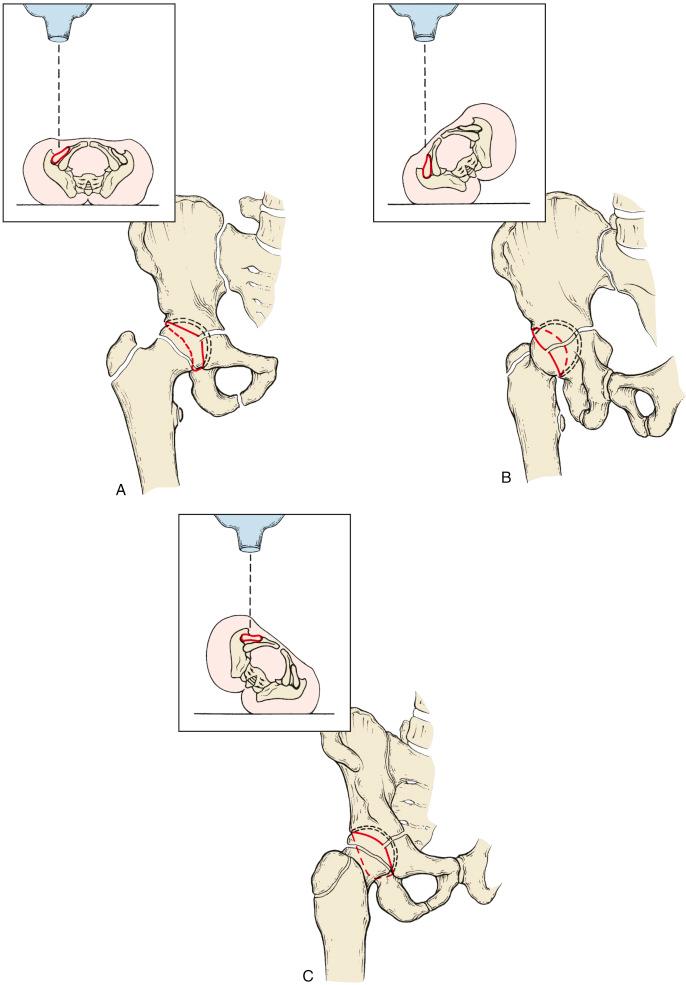
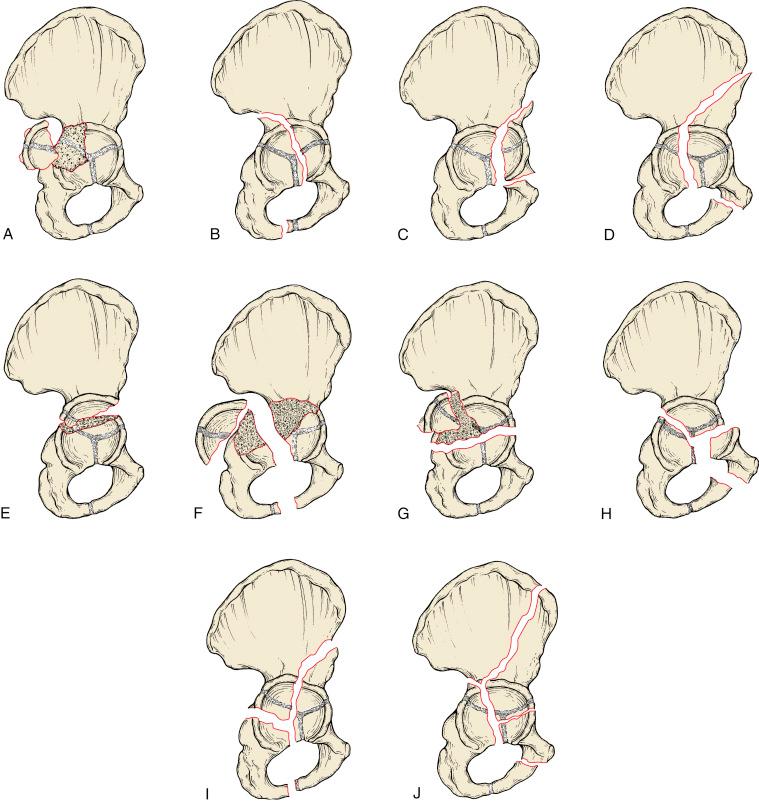
Because of the complex anatomy of the innominate bone, fractures of the acetabulum require a different approach for radiographic evaluation. The 45-degree oblique views described by Letournel and associates are indicated when the scout AP pelvic film demonstrates involvement of the acetabulum. The iliac oblique view shows the posterior column in profile, as well as the iliac ring and anterior wall. The obturator oblique view places the anterior column in profile and shows the obturator foramen clearly, as well as the posterior wall. The two views, combined with the AP pelvic view, allow the physician to classify the fracture according to the scheme of Letournel and Judet ( Fig. 11.7 ). CT is an important adjunct to these conventional radiographic views but is not a substitute. It is especially helpful for detecting intraarticular loose fragments, which occur commonly in patients with associated hip dislocation. CT also helps define fragments impacted in the acetabular margin (posterior wall), as well as occult posterior pelvic ring fractures. Sacral fractures can easily be missed without CT imaging.
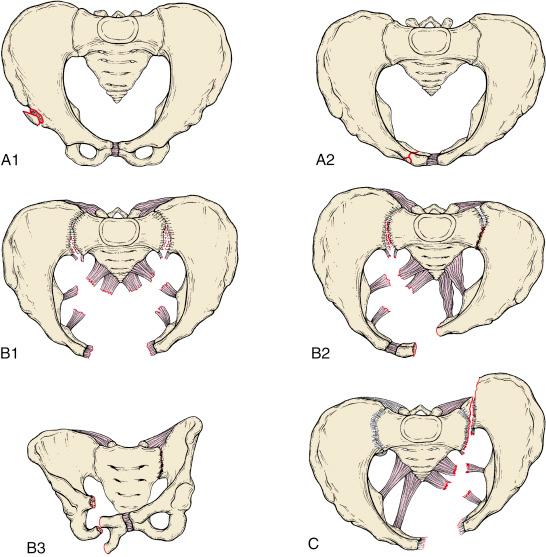
When evaluating radiographic studies of the pediatric trauma patient, it is important to pay special attention to the status of the triradiate cartilage, as this has been shown to be a reliable indicator of skeletal maturity. A number of studies have found differences in pelvic fracture patterns based on the status of the triradiate cartilage. Both and found higher rates of unstable pelvic ring injuries, acetabular fractures, and sacral fractures in patients with closed triradiate cartilages. Furthermore, patients with closed triradiate cartilage lack the elasticity and remodeling potential seen in patients with an immature pelvis and should therefore be treated similar to the adult patients.
In the case of suspected hip dislocation or injury to cartilaginous structures (triradiate cartilage), hip arthrography or magnetic resonance imaging (MRI) may be useful. Although MRI can provide valuable information in regard to cartilage injury in the immature pelvis, it is often difficult to obtain in the acute setting and is contraindicated in the unstable patient. Further information can be found in the section entitled “Hip Dislocations”.
When injury to the lower urinary tract is suspected, either by blood at the urethral meatus or by widely displaced anterior ring fractures, a retrograde urethrogram should be performed. Once a Foley catheter has been definitively placed, a cystogram can be performed to exclude bladder rupture. A urine specimen can be sent for laboratory evaluation for occult hematuria.
The Tile-Pennal ( Fig. 11.7 ) and Young-Burgess ( Fig. 11.8 ) classification systems have historically been used to classify pelvic ring fractures in adults. These classifications systems divide pelvic ring injury–based mechanism of injury and pelvic ring stability. Anterior-posterior compression–type injuries are seen in cases of frontal impacts (head-on MVCs [motor vehicle crashes]) and are associated with higher risk for vascular injury and hemorrhage. LC injuries typically result from side-on collisions (pedestrian versus motor vehicle) and are associated with high rates of abdominal and head injuries. Vertical shear injuries typically result from falls from height. These classification systems are useful in patients with a mature pelvis, including adolescents with a closed triradiate cartilage.
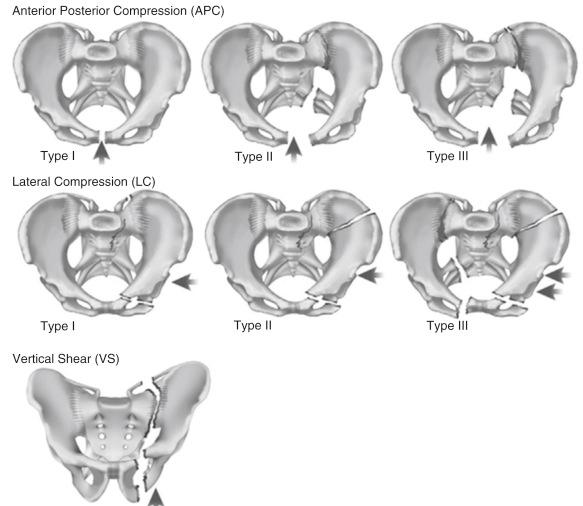
Pediatric patients with an immature pelvis are better described using the Torode and Zieg classification system. The system was originally described in 1985 and classifies pediatric pelvic fractures into four categories (I–IV). The system was further modified by Shore et al in 2012, creating the Modified Torode and Zieg (MTZ) classification, which created two subgroups for type III fractures. This modification reclassified multifocal but stable pelvic ring fractures from type IV fractures, reserving type IV classification for unstable pelvic ring injures ( Fig. 11.9 ). Fracture stability is typically assessed using combined clinical and radiographic examination. Stable fractures demonstrate stability to clinical compression and less than 2 mm of displacement on CT imaging of the anterior and posterior ring injuries. Unstable fractures demonstrate gross clinical instability and/or greater than 2 mm of displacement of both anterior and posterior ring fractures on CT imaging.
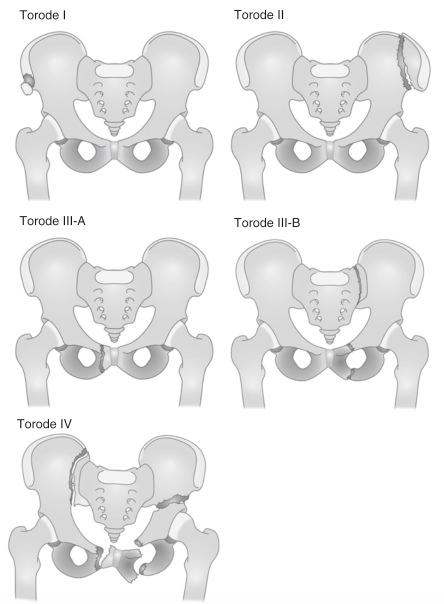
MTZ type I fractures represent avulsion fractures of the immature pelvis. These typically involve separation of bony elements of the pelvis through or adjacent to a cartilaginous growth plate at the site of muscular attachments. Common pediatric pelvic avulsion injuries include the ischial tuberosity, ASIS, and AIIS. Type II fractures involve fractures of the iliac wing and do not disrupt pelvic ring stability. These injuries can be either bony or apophyseal, and are typically the result of a direct blow to the lateral aspect of the pelvis. Type III fractures involve fractures of the pelvic ring but do not result in clinical instability. Type IIIa fractures include simple anterior pelvic ring fractures involving the pubic rami or pubic symphysis disruption. Type IIIb fractures include multifocal pelvic ring injuries with fractures of both the anterior and posterior structures. Although both represent clinically stable fracture patterns, it is important to distinguish between type IIIa and IIIb fractures. Patients with type IIIb fractures exhibit characteristics similar to type IV fractures in regard to length of stay, number of concomitant injuries, and need for blood product transfusion, with type IIIb fractures requiring blood products greater than 2.5 times more frequently than type IIIa fracture. Type IV fractures include unstable pelvic ring injuries, straddle injuries (bilateral superior and inferior pubic rami fractures), pelvic fractures with associated hip dislocation, and pelvic ring injuries with extension into the acetabulum, or combined injuries of the pelvic ring and acetabulum.
For acetabular fractures, the classification of Letournel and Judet is the most universally used system. This system is typically used for skeletally mature patients (closed triradiate cartilage). For skeletally immature patients, the Bucholz classification for acetabular fractures can be used ( Fig. 11.10 ). This system describes the injury to the immature acetabulum using the Salter-Harris classification system and is based on the mechanism of injury and direction of force across the physes of the triradiate cartilage. A shearing-type injury occurs as a result of a blow to the pubis, ischial ramus, or proximal femur and results in an injury between the two superior arms of the triradiate cartilage and the metaphysis of the ilium. This results in a Salter-Harris type I or II fracture. This fracture pattern splits the acetabulum into the superior one-third (weight-bearing) and inferior two-thirds (minimal weight-bearing) portions and is associated with a lower rate of growth disturbance. The second fracture type results from a crushing- or impaction-type injury across the triradiate cartilage and results in a Salter-Harris type V injury. This injury may be difficult to detect on plain imaging and may only become clinically evident after growth arrest has occurred.
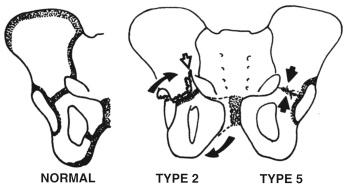
Emergency treatment follows the same protocols established in adult patients and focuses on restoration of hemodynamic stability and damage-control orthopedic surgery. Emergent pelvic bleeding control, provisional pelvic ring fixation, and prompt treatment of life-threatening additional pelvic injuries are the measures necessary for achieving hemodynamic stability. Pelvic fractures associated with significant hemorrhage or concomitant intraabdominal injury requiring laparotomy may benefit from more aggressive emergency treatment. This situation is rare in children. Direct retroperitoneal or preperitoneal packing has been shown to be effective in stabilizing hemodynamically unstable pediatric pelvic fractures. Embolization should be considered in the setting of patients not responding to direct packing, although the survival rate is not significantly improved in those cases. Pelvic hemorrhaging frequently responds to closing down the pelvic volume. This may be accomplished using a pelvic binder or sheeting technique. Recently, pelvic straps have been developed that are placed at the level of the trochanters and can be tightened and held with Velcro, closing down the pelvic volume. Caution with other compressive techniques, such as antishock trousers, should be used, as they can cause more harm than benefit to the patient. Open fractures require intravenous (IV) antibiotics and urgent irrigation and débridement. After appropriate resuscitation, definitive fracture management is initiated after the full diagnostic evaluation is complete.
It is estimated that between 77% and 94% of all pediatric pelvic fracture patients can be successfully treated nonoperatively. Indications for nonoperative treatment of skeletally immature pelvic fractures and ring injuries include minimally displaced modified Torode and Zeig type I to III fractures in patients without evidence of hemodynamic instability. Straddle injuries, although considered type IV injuries, can typically be treated nonoperatively, as only the anterior ring is disrupted.
Methods of nonoperative treatment have historically included bed rest, protected weight-bearing, immobilization, skeletal traction, and pelvic sling or binder. However, long periods of bed rest and immobilization have fallen out of favor because of the additional risks this places on the polytrauma patient with multiorgan system injuries. For this reason, a short period of immobilization and/or non-weight-bearing, followed by early rehabilitation and mobilization, has become common place in nonoperative treatment of children with pelvic fractures. Typically, the patient is initially kept non-weight-bearing on the affected side. Spica cast immobilization maybe useful in young children during the early immobilization period.
The patient is followed radiographically on a weekly basis to monitor for fracture displacement and callus formation. Once callus formation has begun, the patient may be progressed to partial weight-bearing and begin the rehabilitation process with isometric muscle exercises. Fracture union can be expected between 6 and 8 weeks, depending on the patient’s age, at which time, the patient may be progressed to weight-bearing as tolerated. The patient should be followed clinically and radiographically periodically in the first 1 to 2 years after injury to monitor for signs of pelvic growth arrest.
Indications for distal femoral pin traction include a vertical shear injury through the iliac wing, SI joint, or sacrum that is shown to be reduced in traction. This injury generally occurs in children younger than 8 to 10 years. Contraindications to skeletal traction treatment include lateral compression injuries, open-book A2 injuries, and stable avulsion-type fractures. In addition, fractures that do not achieve reduction in traction should not be definitively managed with this form of treatment because leg-length discrepancy may result.
A distal femoral Steinmann pin is inserted approximately 2 to 3 cm proximal to the distal femoral physis under fluoroscopic control. A traction bow is applied and weight added. As much as 10 to 20 kg may be necessary for reduction of the fracture, depending on the child’s age and body habitus. The opposite leg may be held in skin traction so that significant abduction does not occur; this is more often necessary in children younger than 8 years. If reduction to within 2 mm is not obtained within 5 days, despite increasing weight, traction should be discontinued and consideration given to reduction and fixation. Traction should continue for 4 weeks in children younger than 10 years and for 6 weeks in those ages 10 to 14 years. Strong consideration should be given to open surgical treatment of displaced vertical shear fractures in adolescents 12 years and older. As previously mentioned, skeletal traction typically requires prolonged bed rest and may not be the best option in trauma patients with multisystem injuries.
In the literature, treatment of pediatric pelvic fractures has been nearly universally conservative until the past decade. However, more recent evidence suggests that the outcome of unstable pelvic fractures in pediatric patients are poor with conservative treatment. Schwarz et al reported on 17 skeletally immature patients with unstable pelvic fractures treated nonoperatively. At final follow-up ranging from 2 to 25 years, all patients demonstrated poor clinical outcomes, including low back pain and pelvic asymmetry with varying degrees of functional impairment. Similarly, Smith et al retrospectively reviewed 20 patients with open triradiate cartilage treated for unstable pelvic fractures. They defined pelvic instability as displacement of the pelvic ring that occurs with normal weight-bearing. In their review, patients with pelvic asymmetry greater than 1 cm demonstrated poor outcomes associated with low back pain, compensatory scoliosis, SI pain, and Trendelenburg gait. For this reason, the authors recommended operative treatment of all unstable pelvic fractures with greater than 1 cm of pelvic asymmetry. A number of authors have proposed several other indications for operative fixation of pediatric pelvic fractures. These include fractures with concomitant soft tissue injures requiring open wound treatment, need for additional stabilization during resuscitation of a hemodynamically unstable patient, and optimization of patient mobility.
In skeletally immature patients, Torode and Zieg type IV fractures comprise the majority of operatively treated pelvic fractures. Further indications include displaced vertical sacral fractures, displaced and unstable SI joint dislocations, and displaced iliac wing fractures with extension into the SI joint or acetabulum. In patients with a closed triradiate cartilage, pelvic fractures behave very similar to those seen in adults and should therefore be classified and treated in a such a manner. This may include consultation with an adult orthopedic trauma specialist, depending on the resources of the treating facility. The goals of operative treatment are anatomic reduction with stable fixation. Techniques for operative treatment of pediatric pelvic fractures typically include closed reduction and external fixation versus open reduction and internal fixation.
The indications for external fixation include stabilization of anterior pelvic ring instability, hemodynamic instability, patients with open pelvic fractures, and in polytrauma situations. Although external fixation may provide definitive stability for anterior ring disruptions, this method of treatment cannot hold reductions of displaced posterior ring injuries. A pelvic C-clamp may be useful in these situations. An external fixator with a modular frame can be used to treat an open-book pelvic ring fracture or can be used as a supplemental anterior fixation for Tile B2, B3, and C fractures after a posterior SI injury has been stabilized ( Figs. 11.11 and 11.12 ).
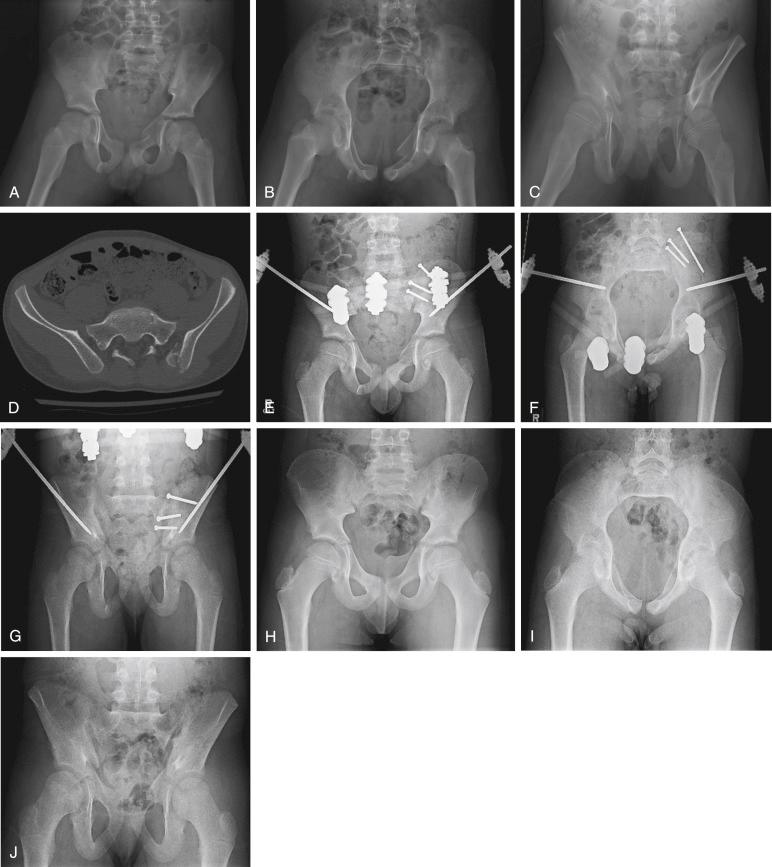
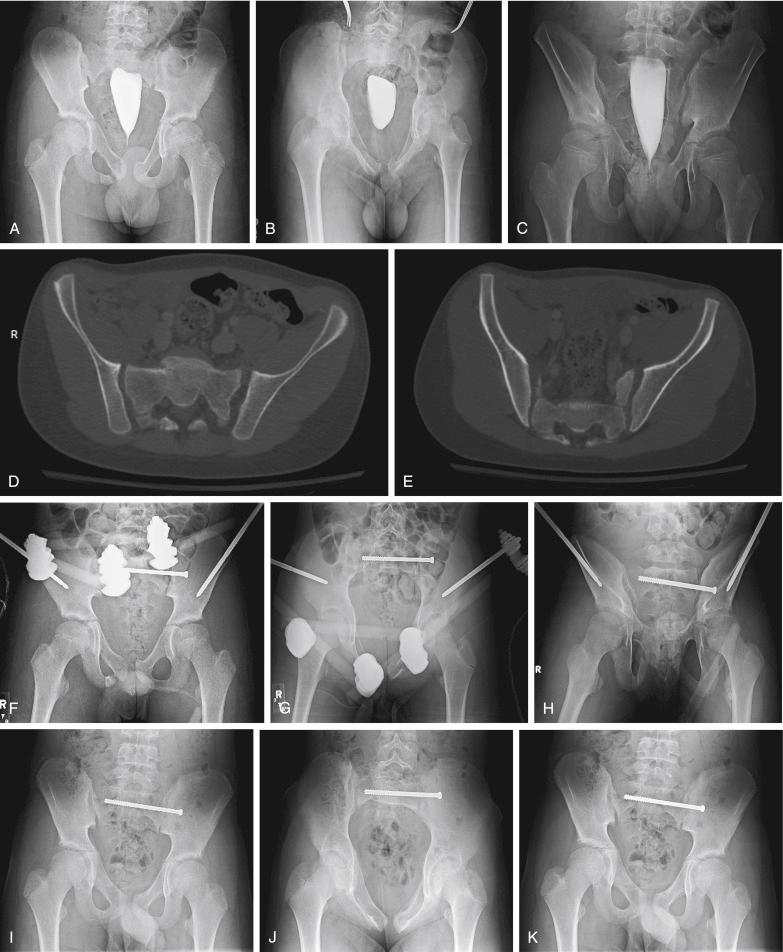
General anesthesia is the technique of choice for either resuscitative application or definitive reduction. The patient is positioned supine for application of the frame.
Before frame placement, open wounds should be irrigated and débrided. Pins of appropriate diameter are selected for the patient’s age and size. For children older than 8 years, standard 5-mm pins are appropriate. In children younger than 8 years old, 4-mm pins can be used. Fixation can be obtained with either iliac crest or supra-acetabular pins. Supra-acetabular pins have been shown to be biomechanically superior to iliac crest pins in adult patients. When placing iliac crest pins, smooth pins are preferred to treaded Steinmann pins to decrease the risk for iatrogenic injury to the apophysis. When placing iliac crest pins, one or two pins in each ilium are introduced through 1-cm stab incisions ( Fig. 11.13 ). The pins are introduced through predrilled holes of slightly smaller diameter, and are placed by hand chuck to minimize the chance of perforation of the inner or outer table of the ilium. This is typically performed under fluoroscopic guidance. Smooth K-wires can be placed on the inner and outer cortices of the iliac ring as directional guides. Supra-acetabular pins are placed in a similar fashion. The obturator oblique fluoroscopic view is used to obtain the appropriate starting point and trajectory, and the iliac oblique view used to judge depth of pin placement. Pins are placed in the bone cephalad to the hip joint and triradiate cartilage to avoid iatrogenic injury. Once the pins are placed on both sides of the pelvis, the pelvic ring injury is reduced and stabilized by application of the frame to the pins. Reduction and pin placement should be confirmed fluoroscopically. Adequate room should be left between the bars and the abdomen to allow patient mobility and repeated abdominal examinations. Regular radiographs are used to monitor for loss of reduction and fracture healing. External fixation frames may be removed once sufficient callus formation is observed, which typically occurs by 4 to 6 weeks in pediatric patients.
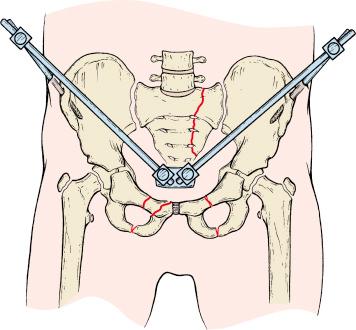
Indications for open reduction and internal fixation of pediatric pelvic fractures include open fractures, displaced fractures with greater than 1 cm of pelvic asymmetry, and injuries with posterior ring instability. These typically include displaced Tile-Pennal types A2, B1, B2, C1, and C2 fractures, as well as most Torode and Zieg type IV fractures and displaced vertical shear injuries. Inadequate closed reduction or failure to maintain reduction with immobilization or external fixation are relative indications for open reduction internal fixation. This often occurs in fractures treated more than 5 days from time of injury.
Operative treatment of displaced pelvic fractures in the hemodynamically stable patient is optimally done 48 to 72 hours after injury. Active hemorrhaging will have ceased by then, and preoperative studies such as CT scans can be obtained and carefully reviewed. Delaying operative reduction more than 5 to 7 days increases the difficulty of obtaining anatomic reduction.
Selection of the surgical approach is based on the location of the posterior ring injury. The plain radiographs and CT scans are studied for determination of optimal positioning of the implants. In patients younger than 10 years, 3.5- or 4.5-mm cannulated or 3.5-mm cortical screws are the optimal implants. Screws up to 100 mm in length should be available.
A general anesthetic is appropriate for all closed or open pelvic reductions. The patient is positioned supine for anterior ring approaches. Sacroiliac joint or posterior iliac ring injuries can be addressed with the iliac fossae portion of the ilioinguinal approach. For posterior approaches to the SI joint and for displaced sacral fractures, the patient may be positioned supine or prone. In both instances, the patient should be on a radiolucent table with C-arm available to confirm placement of the hardware intraoperatively.
For anterior ring injuries, a modified Stoppa approach can be used to gain access to the pubic symphysis, the pubic rami, the quadrilateral surface, the pubic eminence, and the infrapectineal surface. It also allows visualization of posterior structures, including the sciatic buttress, sciatic notch, and the anterior SI joint. For symphysis disruptions, fracture fixation should be accomplished utilizing the smallest footprint possible. A simple two-hole one-third tubular plate or two- to four-hole small fragment or reconstruction plate may be used for fixation ( Fig. 11.14 ). Longer reconstruction plates may be used when increased stability is required. Alternatively, in very young patients, transosseous suturing of the pubic symphysis may be performed. This allows safe fixation without disruption of the symphyseal physes, and may obviate the need for subsequent implant removal.
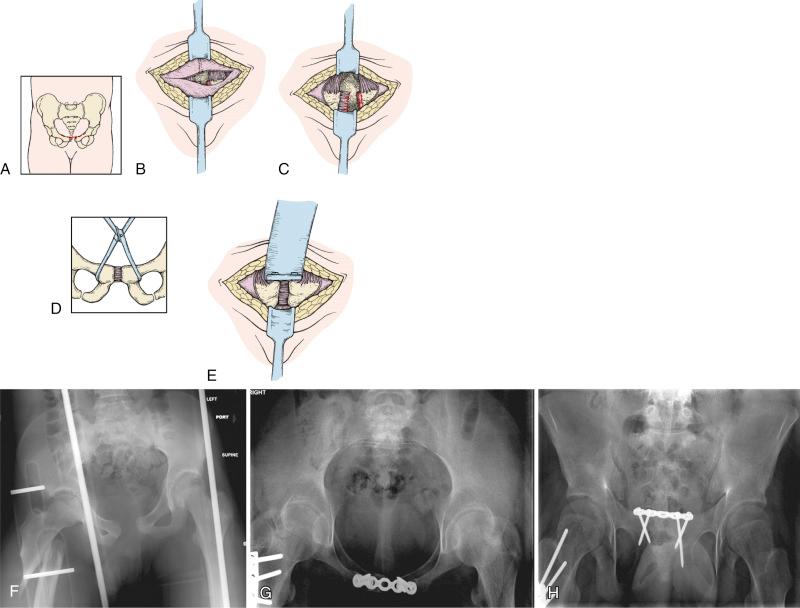
Sacral fractures, crescent fractures, and disruptions of the SI joint in children can often be stabilized with 3.5- or 4.5-mm cannulated screws placed percutaneously under fluoroscopic control and the patient in the supine position ( Fig. 11.15 ). Experience with this technique is required because of the high frequency of sacral anatomic variations and the technical difficulty of this procedure. A preoperative CT scan should be obtained and analyzed to map the size and trajectory of the S1 and S2 corridors and determine if safe screw passage is possible. Burn et al recently evaluated the safety of placing iliosacral and transiliosacral screws in pediatric patients aged 2 to 16 years. Their results demonstrated a safe corridor for placement of S1 iliosacral screws (99%) and S2 transiliosacral screws (89%) in nearly all patients. However, only 51% of patients demonstrated a safe corridor for S1 transiliosacral screw placement. Furthermore, safe placement of percutaneous iliosacral screws has been described in children as young as 20 months of age. Recently, some authors have advocated for placement of percutaneous SI screws under CT guidance. The use of intraoperative CT scanners and combined computer-assisted navigation has been validated and is being used with increased frequency. A number of studies have demonstrated the safety and accuracy of these systems, even in the hands of less experienced surgeons. In cases with a comminuted sacral fracture, it is very important to not overcompress the fracture. This may lead to compression of the sacral foramina and result in sacral nerve root injury. To avoid this, a full-threaded positional screw may be placed across the fracture.
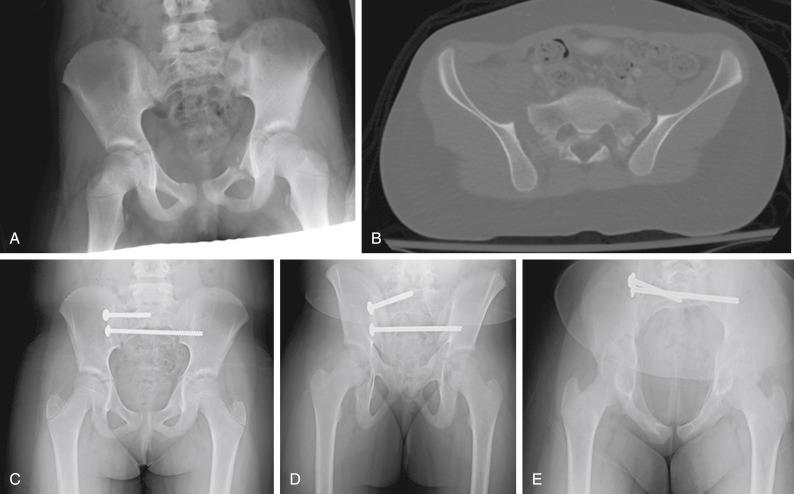
Often, reduction of the anterior ring injury results in indirect reduction of the posterior ring. However, in unstable injuries, this may not be the case. In such cases, the operative approach and fixation are often dictated by a number of factors including location of the fracture/dislocation, amount of displacement, and concomitant soft tissue injury. The SI joint can be stabilized in an open fashion with one or more two-hole 3.5-mm dynamic compression plates, with one screw placed in the sacrum and the other one is in the iliac wing. Transiliac fracture dislocation, also known as a crescent fracture, can typically be treated with posterior screw fixation of the iliac fracture with 3.5-mm or 4.5-mm lag screws. This can be combined with anterior ring external fixation when needed ( Fig. 11.11 ).
The duration and type of immobilization depend on the fracture type and method of treatment. Typical healing time for pediatric pelvic and acetabular fractures ranges from 6 to 8 weeks. However, this may be as short as 4 to 6 weeks for children younger than 7 years, or as long as 10 to 12 weeks for adolescents older than 14 years. Surgically treated pelvic fractures can be mobilized with a walker or crutches. The patient may be full weight-bearing on the intact side of the pelvis and non-weight-bearing on the injured side. Once radiographic evidence of fracture healing is seen, the patient’s weight bearing status may be progressed. Caution must be exercised in patients who have significant posterior pelvic ring displacement, and frequent radiographs are recommended.
Other than for crutch ambulation instruction, physical therapy is not generally required for children with pelvic or acetabular fractures. Swimming is excellent rehabilitative therapy for both pelvic and acetabular fractures and can be initiated 6 to 8 weeks after injury.
Removal of implants is necessary only in children with significant growth remaining. Children younger than 10 years with implants transfixing the SI joint or symphysis pubis implant removal 6 to 12 months after injury is recommended. Removal of implants placed in the ilium, ischium, or pubis to fixate anterior ring or acetabular fractures in children younger than 8 to 10 years old is also recommended. This is done to decrease risk of growth restriction and to allow for further corrective procedures as needed.
Acetabular fractures should be managed after achieving hemodynamic stability. Reduction of concomitant hip dislocation should occur urgently in the emergency department under conscious sedation. Skeletal traction may be required to maintain reduction and take pressure off of the cartilage in fracture-dislocation cases.
Bed rest or non-weight-bearing ambulation with crutches is appropriate only for nondisplaced or fractures with less than 2 mm of displacement. The patient must be closely supervised so that weight-bearing ambulation is prevented. Similarly, patients allowed touchdown weight-bearing with crutches on the injured side must be carefully supervised to avoid weight-bearing forces being transmitted across the fracture surface and subsequent displacement. Such treatment is appropriate only for older children who can be relied on to cooperate with these instructions. Regular imaging is required to monitor for fracture displacement.
Traction treatment is appropriate only for acetabular fractures that are reducible to less than 1 to 2 mm of displacement. However, because of the elastic nature of skeletal tissue in children, this is rarely the case. A traction pin should be inserted in the distal end of the femur under fluoroscopic control and with the patient under anesthesia so that physeal injury is avoided. The fracture must be followed with regular radiographs to monitor for maintained reduction. Fracture patterns that may be reducible with traction include two-column fractures and associated variants. Isolated columnar injuries or posterior wall fractures are not generally reducible with traction.
All acetabular fractures with 2 mm or greater of displacement documented on CT or MRI should undergo operative reduction and internal fixation. Additional indications for operative treatment include nonconcentric hip joint reduction (fracture dislocations), incarcerated fragments in the hip joint, and acetabular fractures with associated unstable pelvic ring injury. The surgical approach varies according to the fracture pattern and the nature and direction of the displacement. Preoperative CT scans and radiographs are used to determine the optimal approach and fixation techniques. Posterior fractures, including those of the posterior wall and posterior column, are generally accessible through the Kocher-Langenbeck approach. During this approach, it is important to protect and preserve the blood supply to the femoral head. The Kocher-Langenbeck approach may be performed with the patient in the prone or lateral decubitus position. When the approach is being performed for a fracture involving the posterior column, it is typically done with the patient prone, as described by Letournel and colleagues. Anterior column injuries are optimally managed with the ilioinguinal or modified Stoppa approaches. Some transverse fractures and transverse fractures with associated posterior wall injuries may require the extended iliofemoral approach or combined anterior and posterior approaches. However, this is rarely necessary and is associated with greater blood loss and a higher incidence of heterotopic ossification.
Internal fixation is typically performed with 2.0-mm, 2.4-mm, 2.7-mm, or 3.5-mm screws and reconstruction plates, depending on the size of the patient and size of the fracture fragments ( Fig. 11.16 ). As previously mentioned, children have thicker periosteum than in adults. This thick periosteum can become entrapped in the fracture site and must be removed to facilitate accurate fracture reduction. Fracture fragments that are too small for fixation may be excised as needed to allow for concentric hip reduction. Multiple assistants, Schanz pins, femoral distractors, specialized pelvic clamps, and long screws should be available as needed. A surgeon experienced in acetabular fracture approaches and fixation in adults should be consulted for all operative pediatric acetabular fractures.
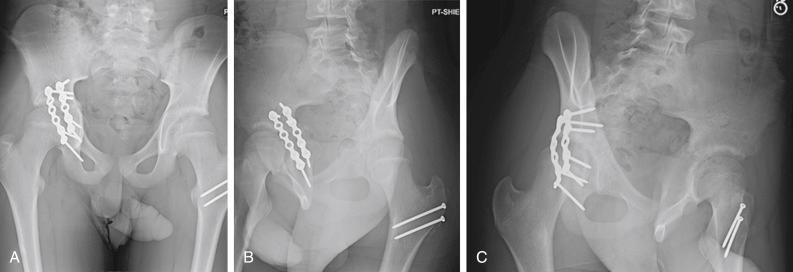
Become a Clinical Tree membership for Full access and enjoy Unlimited articles
If you are a member. Log in here